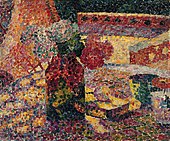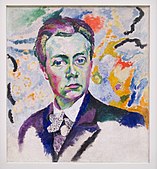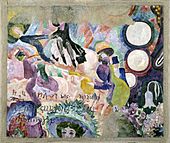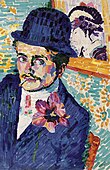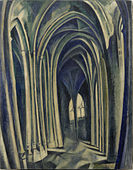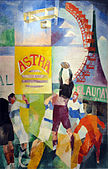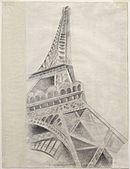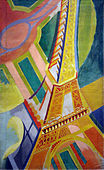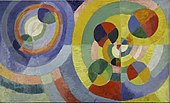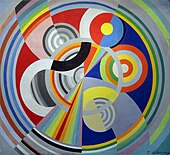Robert Delaunay
Robert Delaunay | |
|---|---|
 Robert Delaunay | |
| Born | Robert-Victor-Felix Delaunay 12 April 1885 Paris, France |
| Died | 25 October 1941 (aged 56) Montpellier, France |
| Known for | Painting |
| Movement | Divisionism, Cubism, Orphism, Abstract art, School of Paris |
| Signature | |
Robert Delaunay (French pronunciation:
Overview
This section possibly contains original research. (October 2023) |
Delaunay is most closely identified with Orphism. From 1912 to 1914, he painted nonfigurative paintings based on the optical characteristics of brilliant colors that were so dynamic they would function as the form. His theories are mostly concerned with color and light and influenced many, including Stanton Macdonald-Wright, Morgan Russell, Patrick Henry Bruce, Der Blaue Reiter, August Macke, Franz Marc, Paul Klee, and Lyonel Feininger. Art critic Guillaume Apollinaire was strongly influenced by Delaunay's theories of color and often quoted from them to explain Orphism, which he had named.[2] Delaunay's fixations with color as the expressive and structural means were sustained by his study of color.
In the prime of his career he painted a number of series that included: the Saint-Sévrin series (1909–10); the City series (1909–1911); the
His early paintings are deeply rooted in
The spectral colors of Neoimpressionism were later abandoned. The Eiffel Tower series represented the fragmentation of solid objects and their merging with space. Influences in this series were Cézanne, Analytical Cubism, and Futurism. In the Eiffel Tower the interpenetration of tangible objects and space is accompanied by the intense movement of geometric planes that are more dynamic than the static equilibrium of Cubist forms.
Biography
Early life
Robert Delaunay was born in
Career beginnings
At age 19, Delaunay left Ronsin to focus entirely on painting and contributed six works to the
Delaunay formed a close friendship at this time with Jean Metzinger, with whom he shared an exhibition at a gallery run by Berthe Weill early in 1907. The two of them were singled out by the art critic Louis Vauxcelles in 1907 as Divisionists who used large, mosaic-like 'cubes' to construct small but highly symbolic compositions.[5]

Robert Herbert writes: "Metzinger's
Metzinger, followed closely by Delaunay—the two often painting together in 1906 and 1907—would develop a new sub-style of Neo-Impressionism that had great significance shortly thereafter within the context of their Cubist works.

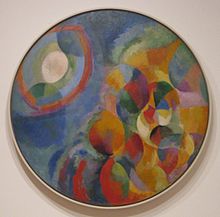
In 1908, after a term in the military working as a regimental librarian, he met
The following year, he married Terk, and the couple settled in a studio apartment in Paris, where their son Charles was born in January 1911. The same year, at the invitation of Wassily Kandinsky, Delaunay joined The Blue Rider (Der Blaue Reiter), a Munich-based group of artists. Delaunay was also successful in Germany, Switzerland, and Russia. He participated in the first Blaue Reiter exhibition in Munich and sold four works. Delaunay's paintings encouraged an enthusiastic response with Blaue Reiter. The Blaue Reiter connections led to the article by Erwin von Busse titled "Robert Delaunay's Methods of Composition", which appeared in the 1912 Blaue Reiter Almanac.[11] Delaunay would go to exhibit in February of that year, in the second Blaue Reiter exhibition in Munich and Knave of Diamonds in Moscow.

"This happened in 1912. Cubism was in full force. I made paintings that seemed like prisms compared to the Cubism my fellow artists were producing. I was the heretic of Cubism. I had great arguments with my comrades who banned color from their palette, depriving it of all elemental mobility. I was accused of returning to Impressionism, of making decorative paintings, etc.… I felt I had almost reached my goal."[13]
1912 was a turning point for Delaunay. On 13 March his first major exhibition in Paris closed after two weeks at the Galerie Barbazanges. The exhibition, organized by the French mathematician and actuary Maurice Princet, showed forty-six works from his early 1906-07 Divisionist period to his Proto-Cubist and Cubist Eiffel Tower paintings from 1909 to 1912. Apollinaire praised those works of the exhibition and proclaimed Delaunay as "an artist who has a monumental vision of the world."
In the 23 March 1912 issue of the satirical magazine L'Assiette au Beurre, the first published suggestion that Delaunay had broken with this group of Cubists appeared, in James Burkley's review of the Salon des Indépendants. Burkley wrote, "The "Cubists", who occupied only a room, have multiplied. Their leaders, Picasso and Braque, have not participated in their grouping, and Delaunay, commonly labeled a Cubist, has wished to isolate himself and declares he has nothing in common with Metzinger or Le Fauconnier."[14]
With Apollinaire, Delaunay traveled to Berlin in January 1913 for an exhibition of his work at Galerie Der Sturm. On their way back to Paris, the two stayed with August Macke in Bonn, where Macke introduced them to Max Ernst.[15] When his painting La ville de Paris was rejected by the Armory Show as being too big[16] he instructed Samuel Halpert to remove all his works from the show.[4]
Spanish and Portuguese years (1914–1920)
At the outbreak of the
The
Paul Poiret refused a business partnership with Sonia in 1920, citing as one of the reasons her marriage to a deserter.[19] The Der Sturm gallery in Berlin showed works by Sonia and Robert from their Portuguese period the same year.[4][20]
Return to Paris and later life (1921–1941)

After the war, in 1921, they returned to Paris. Delaunay continued to work in both figurative and abstract themes, with a brief stint into
When
Gallery
-
Robert Delaunay, c.1907, Nature morte au vase de fleurs, oil on canvas, 46.4 x 55 cm
-
Robert Delaunay, 1905–06, Autoportrait, oil on canvas, 54 x 46 cm, Musée National d'Art Moderne, Paris
-
Robert Delaunay, 1906, Carousel of Pigs (Manège de cochons), oil on canvas, 113.7 × 130.8 cm, Solomon R. Guggenheim Museum
-
Robert Delaunay, 1906, Jean Metzinger, oil on paper, 54.9 x 43.2 cm, Museum of Fine Arts, Houston
-
Robert Delaunay, 1906, L'homme à la tulipe (Portrait de M. Jean Metzinger), oil on canvas, 72.4 x 48.5 cm. Exhibited in Paris at the 1906 Salon d'Autome (no. 420) along with a portrait of Delaunay by Metzinger
-
Robert Delaunay, 1907, Portrait of Wilhelm Uhde. Robert Delaunay and Sonia Terk met through the German collector/dealer Wilhelm Uhde, with whom Sonia had been married as she said for "convenience"
-
Robert Delaunay, 1907, Still Life with a Parrot, oil on canvas, 82.5 x 66.5 cm, Unterlinden Museum. Another version of that painting belongs to the Thyssen-Bornemisza Museum.
-
Robert Delaunay, 1909–10, Saint-Séverin No. 3, oil on canvas, 114.1 × 88.6 cm, Solomon R. Guggenheim Museum
-
Robert Delaunay, 1910–1912, La Ville de Paris, oil on canvas, 267 × 406 cm, Musée National d'Art Moderne
-
Robert Delaunay, 1911–12, Window on the City No. 3, oil on canvas, 113.7 × 130.8 cm, Solomon R. Guggenheim Museum
-
Robert Delaunay, 1912, Simultaneous Windows on the City, 40 x 46 cm,Kunsthalle Hamburg
-
Robert Delaunay, 1912, Windows Open Simultaneously 1st Part, 3rd Motif, oil on canvas, 57 × 123 cm, Solomon R. Guggenheim Museum
-
Robert Delaunay, 1913, L'Équipe de Cardiff, oil on canvas, 195 x 130 cm, Van Abbemuseum, Eindhoven
-
Robert Delaunay, 1913, L'Équipe de Cardiff, oil on canvas, 326 × 208 cm, Musée d'Art Moderne de Paris
-
Robert Delaunay, 1914, Homage to Blériot, oil on canvas, Museum of Grenoble
-
Robert Delaunay, 1915, Nu à la toilette (Nu à la coiffeuse), oil on canvas, 140 × 142 cm,Musée d'Art Moderne de la Ville de Paris
-
Robert Delaunay, 1916, Portuguese Woman, oil on canvas, 135.9 × 161 cm, Columbus Museum of Art
-
Robert Delaunay, 1926–1928, Eiffel Tower, Conté crayon on paper, 62.3 × 47.5 cm, Solomon R. Guggenheim Museum, New York, The Hilla Rebay Collection
-
Robert Delaunay, 1926, Tour Eiffel, oil on canvas, 169 × 86 cm,Musée d'Art Moderne de la Ville de Paris
-
Robert Delaunay, 1930, Circular Forms, oil on canvas, 67.3 × 109.8 cm, Solomon R. Guggenheim Museum, New York, Gift by Andrew Powie Fuller and Geraldine Spreckels Fuller Collection, 1999
-
Centre Georges Pompidou
-
Robert Delaunay, 1938, Rythme n°1, Decoration for the Salon des Tuileries, oil on canvas,Musée d'Art Moderne de la Ville de Paris
Museum collections
Robert Delaunay's works can be found in museums and loaned from private collections around the world:
Europe
The Musée National d'Art Moderne in Paris, the Musée d'Art Moderne de Paris, the Neue Nationalgalerie in Berlin, the Bilbao Fine Arts Museum (Spain), Kunstmuseum Basel (Switzerland), the
United States
The
Rest of the world
The National Gallery of Victoria (Australia), the Aichi Prefectural Museum of Art (Japan).
Publications
- Baron, Stanley; Damase, Jacques (1995). Sonia Delaunay: The Life of an Artist. Harry N. Abrahams. ISBN 0-8109-3222-9.
- Düchting, Hajo (1995). Delaunay. Taschen. ISBN 3-8228-9191-6.
- Robert Delaunay – Sonia Delaunay: Das Centre Pompidou zu Gast in Hamburg. Hamburger Kunsthalle. 1999. ISBN 9783770152162.
- Gordon Hughes (1997). Envisioning Abstraction: The Simultaneity Of Robert Delaunay's First Disk.
See also
- Abstraction Creation
References
- ^ Voorhies, Authors: James. "School of Paris | Essay | The Metropolitan Museum of Art | Heilbrunn Timeline of Art History". The Met’s Heilbrunn Timeline of Art History. Retrieved 2023-11-26.
- ^ Jenkins, Sarah. "Robert Delaunay Biography, Life & Quotes". The Art Story. Retrieved 25 February 2022.
- ^ Düchting: p7
- ^ ISBN 3-7701-5216-6
- ^ "History of Art: Jean Metzinger". www.all-art.org. Archived from the original on 2018-01-12. Retrieved 2012-06-15.
- ^ a b Robert Herbert, Neo-Impressionism, The Solomon R. Guggenheim Foundation, New York, 1968
- ^ Rijksmuseum Kröller-Müller, Otterlo, Jean Metzinger, Coucher de soleil No. 1 Archived 2012-07-09 at archive.today
- ^ (n.d.). Robert Delaunay. Champs de Mars: The Red Tower, (1911/23). Art Institute of Chicago.
- ^ (n.d.). Robert Delaunay. Simultaneous Contrasts: Sun and Moon Paris, (1913). Museum of Modern Art, New York. Retrieved April 5, 2020.
- ^ Robert Delaunay, Simultaneous contrasts: Sun and moon, 1912, (video). Museum of Modern Art, New York. Retrieved April 4, 2020
- ^ E. van Busse. "Robert Delaunay's Methods of Composition". In Kandinsky, Wassily; Marc, Franz (eds.). The Blaue Reiter Almanac. New York: Viking Press. pp. 119–23.
- ^ Robert Delaunay, Premier disque, (1912). artdesigncafe. Retrieved April 4, 2020.
- ISBN 9780670506361– via Google Books.
- ^ James Burkley, L'Assiette au Beurre, 23 March 1912, Gallica, Bibliothèque nationale de France
- ISBN 0-7914-3195-9, p82
- ^ La ville de Paris measures 234 x 294 cm.
- ^ Some sources mention an Eduardo Vianna
- ^ Düchting: p51
- ISBN 3-7701-5216-6.
- ^ Düchting: p91
- ^ Surréalisme, Manifeste du surréalisme, Volume 1, Number 1, 1 October 1924, Blue Mountain Project
- ^ Robert Delaunay, Museo Nacional Thyssen-Bornemisza

